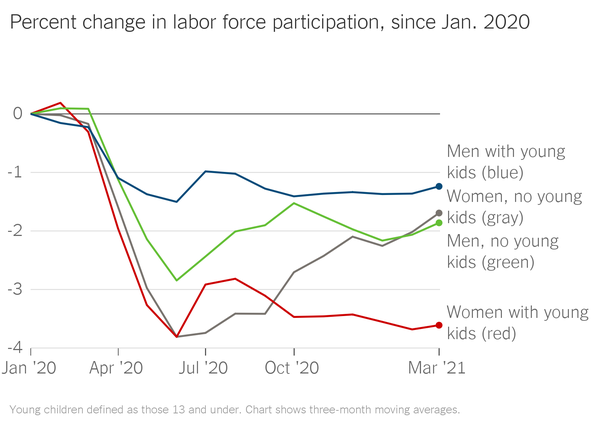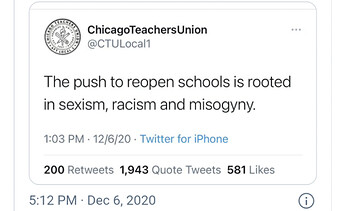In the New York Times “The Morning” free email this morning:
’Not enough to sort of open’
With the U.S. economy growing rapidly, millions of people have returned to work. Yet there is still one large group of Americans whose employment rates remain far below their prepandemic levels — mothers of young children.
Consider this data, which Moody’s Analytics compiled for The Morning:

The explanation is obvious enough. Many schools and day care centers have not returned to normal operations. They are open for only a few hours a day, a few days a week or on alternating weeks, making it difficult for parents to return to a full-time job. And parenting responsibilities still fall disproportionately on women.
This situation is unlikely to change over the final month or two of the current school year. But it raises a major question about the start of the next school year, in August and September: Will schools fully reopen — every day, Monday through Friday, and every week?
If they do not and instead maintain a hybrid approach, it will exact a heavy cost on American women. The biggest issue of gender equality in 2021 may well be whether schools return to near-normal this fall.
“Fully opening schools is the single most important thing,” my colleague Claire Cain Miller, who writes about gender and work, told me. “Obviously, parents can’t get back to work without that.”
“It’s not enough to sort of open,” said Emily Oster, an economist at Brown University who studies parenting. “We are going to need to figure out how to make it possible to open normally.”
Is it safe to open?
Fortunately, the available evidence indicates that schools can safely return to normal hours in the fall. Nearly all teachers have already had the chance to be vaccinated. By August, all children who are at least 12 are also likely to have had the opportunity. (The Pfizer vaccine is now available to people 16 and up, and federal regulators appear set to approve it for 12- to 15-year-olds in coming weeks.)
Few younger children — maybe none — will have been vaccinated by the fall. But data from both the U.S. and other countries suggests that children rarely infect each other at school. One reason is that Covid-19 tends to be mild for younger children, making them less likely to be symptomatic and contagious.
Even more important, this coronavirus rarely harms children. For them, the death rate resembles that of a normal flu, and other symptoms, like “long Covid,” are extremely rare. Covid presents the sort of small health risk to children that society has long accepted without closing schools. A child who’s driven to school almost certainly faces a bigger risk from that car trip than from the virus.
Of course, the risk from Covid is not zero, which is why many school districts are still grappling with what to do in the fall. Covid has so thoroughly dominated our thinking over the past 14 months that many people continue to focus on Covid-related issues — even highly unusual or uncommon ones — to the exclusion of everything else.
Covid does present a minuscule risk to children. And there will also be some teachers and other school employees who choose not to be vaccinated or who cannot receive a vaccine shot for health reasons; some of them may need to remain home if schools reopen.
For these reasons, a full reopening of schools will bring real, if small, costs and complications. Communities will have to weigh those costs against the enormous damage that closed schools are doing to American women.



